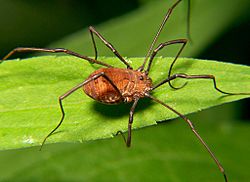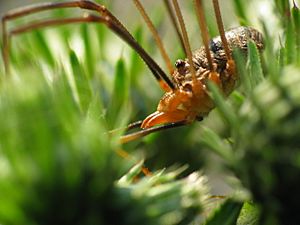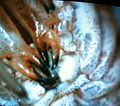Opiliones facts for kids
Quick facts for kids OpilionesTemporal range: Devonian – Recent
|
|
|---|---|
 |
|
| Hadrobunus grandis | |
| Scientific classification | |
| Kingdom: | |
| Phylum: | |
| Class: | |
| Subclass: |
Dromopoda
|
| Order: |
Opiliones
Sundevall 1833
|
| Diversity | |
| 4 suborders, > 6,400 species | |

Harvestmen are amazing eight-legged creatures. Even though they belong to the arachnid family, they are not spiders. They are in their own special group called the order Opiliones or Phalangids.
Scientists have found over 6,400 different kinds of harvestmen. There might be more than 10,000 types living today! Very old fossils of harvestmen have been found in Scotland. These fossils are about 400 million years old. What's cool is that these ancient harvestmen look very much like the ones we see today. This means their basic body plan hasn't changed much over millions of years.
Sometimes, people call harvestmen "daddy longlegs." But this name can be confusing! Two other creatures are also called "daddy longlegs." One is the crane fly, which is an insect. The other is the cellar spider, which is a true spider. Harvestmen are different from both of these.
Many harvestmen are omnivores. This means they eat a mix of things. They often munch on small insects. They also eat some plants and fungi. Some harvestmen are scavengers. This means they eat dead plants or animals they find.
Harvestmen are not dangerous to people. None of the known types have poison glands. They don't have venom or silk glands like true spiders do. So, you don't need to worry if you see one!
What Do Harvestmen Look Like?
Harvestmen often have very long legs compared to their body size. But some types have short legs too! Their two main body parts, the abdomen and cephalothorax, are broadly joined. This makes them look like one oval shape. This is a key difference from spiders.
Unlike spiders, harvestmen do not have venom or silk glands. In some advanced types, the first five parts of their abdomen are joined. This forms a shield on their back called a scutum. Sometimes, only the males have this shield.
The second pair of legs on a harvestman is usually longer than the others. These legs act like antennae. They help the harvestman feel its way around. This can be tricky to spot in species with shorter legs.
Harvestmen eat their food in chunks. They don't need to turn it into liquid first, which is different from many other arachnids. Most harvestmen have one pair of eyes. These eyes are in the middle of their heads. They are usually set horizontally. However, some types of harvestmen don't have any eyes at all!
Find Out More
 In Spanish: Opiliones para niños
In Spanish: Opiliones para niños
- University of Aberdeen: The Rhynie Chert Harvestmen (fossils)
- National Museum page Classification of Opiliones A list of harvestmen types, with some photos.
Images for kids
-
A harvestman eating a skink tail
-
A male Phalangium opilio, showing its long legs and the many small segments at the end of each leg.
-
Tiny mites living on a harvestman











